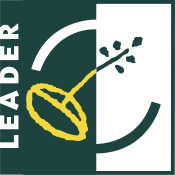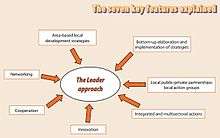LEADER programme
The LEADER programme (an acronym in French – Liaison entre actions de développement de l'économie rurale – meaning Links between actions for the development of the rural economy) is a European Union initiative to support rural development projects initiated at the local level in order to revitalise rural areas and create jobs. LEADER I ran from 1991–93, LEADER II from 1994–99, and LEADER+ from 2000-2006. In the current programming period (2014-2020), the LEADER method has been extended to cover not only rural but also coastal (FARNET) and urban areas under the banner of Community-led Local Development (CLLD).

Operation and objectives
LEADER+ projects are managed by local action groups (LAGs). Each project must involve a relatively small rural area, with a population of between 10,000 and 100,000. In France, the whole country is eligible with the exception of urban areas with over 50,000 inhabitants. France has 140 local action groups.
LEADER+ has three objectives:
- to encourage experiments in rural development
- to support cooperation between rural territories: several LAGs can share their resources
- to network rural areas, by sharing experiences and expertise in the development of rural areas by creating databases, publications and other modes of information exchange
Methodology
From 1991 until 2001 the LEADER methodology was developed with the support of the European Commission's technical assistance contractor, AEIDL. LEADER developed seven principles of local development.

These are:
- Area-based: taking place in a small, homogeneous socially cohesive territory
- Bottom-up: local actors design the strategy and choose the actions
- Public-private partnership: LAGs are balanced groups involving public and private-sector actors, which can mobilise all available skills and resources
- Innovation: giving LAGs the flexibility to introduce new ideas and methods
- Integration: between economic, social, cultural and environmental actions, as distinct from a sectoral approach
- Networking: allowing learning among people, organisations and institutions at local, regional, national and European levels
- Co-operation: among LEADER groups, for instance to share experiences, allow complementarity or to achieve critical mass
Funding
- LEADER I (1991–93) supported 217 LAGS with EU funding of €0.442 billion from the European Agricultural Guidance and Guarantee Fund (EAGGF)[1]
- LEADER II (1994–99) supported 906 LAGs with EU funding of €1.755 billion
- LEADER+ (2000–06) supported 893 LAGs with EU funding of €2.105 billion, and a total budget of €5.05 billion
Follow-up
In 2013 the LEADER approach, which had developed in a rural context, was extended to apply to urban and coastal areas under the title of Community-Led Local Development (CLLD).
References
- European Commission, The Leader approach — A basic guide, Luxembourg: Office for Official Publications of the European Communities, 2006, ISBN 92-79-02044-7